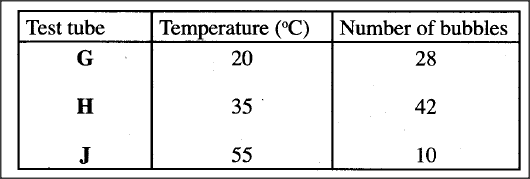K.C.S.E Biology Q & A - MODEL 2012PP2QN03
(a) In an investigation, equal amounts of water was placed in. three test-tubes labelled G, H and J. Pondweeds of equal length were dropped in each test tube. The test-tubes were then placed in identical conditions of light and carbon (IV) oxide at different temperatures for five minutes. After the five minutes, the bubbles produced in each test-tube were counted for one minute. The results were as shown in the table below.
(i) Name one requirement for this process that is not mentioned in the investigation.
(ii) Name the gas produced in this investigation. (iii) Account for the results in test-tubes H and J. (b) State two ways in which the human intestinal villus is adapted to its function.
answers
(a) (i) chlorophyll;
(ii) oxygen; (1 mark) (iii) Test tube H is at optimum temperature for enzyme activity; hence high rate of photosynthesis/more bubbles. In test tube J most enzymes have been denaturedby the high temperature; hence low rate of photosynthesis/fewer bubbles. (b) — The villus epithelium is thin; for faster diffusion of dissolved food substances; — The epithelium has goblet cells; which produce mucus to lubricate food passage; — They have microvilli; which further increase their surface area for absorption; Have lacteal; for absorption of fatty acid & glycerol/transportation of lipids; Highly vascularised; for absorption of digested food.
0 Comments
Leave a Reply. |
Archives
December 2024
Categories
All
TOPICSFORM 1
Form 2
Form 3
Form 4
|
Can't find what you are looking for? Don't worry, Use the Search Box Below.
|
Primary Resources
College Resources
|
Secondary Resources
|
Contact Us
Manyam Franchise
P.O Box 1189 - 40200 Kisii Tel: 0728 450 424 Tel: 0738 619 279 E-mail - sales@manyamfranchise.com |








 RSS Feed
RSS Feed

